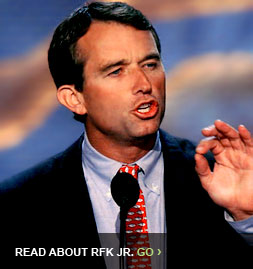Converting rapidly from coal-generated energy to gas is President Barack Obama’s most obvious first step towards saving our planet and jump-starting our economy. A revolution in natural gas production over the past two years has left America awash with natural gas and has made it possible to eliminate most of our dependence on deadly, destructive coal practically overnight – and without the expense of building new power plants.
So writes Robert F. Kennedy Jr., president of Waterkeeper Alliance, in the Financial Times.
RFK Jr. echoes many key points of my series on gas. There appears to be a lot more natural gas than previously thought (Part 1) and therefore unconventional gas makes the 2020 Waxman-Markey target so damn easy and cheap to meet (Part 2), which is great for low-cost climate action, bad for coal (Part 3). And it always bears repeating, as Part 3 discusses, that natural gas is the critical low-carbon “firming” resource that can enable deep penetration of both windpower and concentrated solar thermal power.
Interestingly, the investment site Motley Fool writes about RFK’s article:
[Note: Do not consider this link an endorsement of their stock picks.]
I’ve been touting the success of [Exploration and Production companies] in tackling unconventional gas resources on this site since 2007, I think the impact of shale plays on America’s energy supply has only more recently come to be appreciated. It’s wonderful to see a bona fide environmentalist like RFK Jr. lend his support to natural gas as an abundant and vastly cleaner alternative to coal. With luck, we will see other public figures join him in this call.
Now if the natural gas industry only learned to lobby as effectively as Peabody Energy and the rest of the coal crew, we could see some serious climate progress in relatively short order.
Here are some comments on the rest of the RFK, Jr. piece:
Whatever the slick campaign financed by the powerful coal barons might claim, coal is neither cheap nor clean. Ozone and particulates from coal plants kill tens of thousands of Americans each year and cause widespread illnesses and disease. Acid rain has destroyed millions of acres of valuable forests and sterilised one in five Adirondack lakes. Neurotoxic mercury raining from these plants has contaminated fish in every state and poisons over a million American women and children annually. Coal industry strip mines have already destroyed 500 mountains in Appalachia, buried 2,000 miles of rivers and streams and will soon have flattened an area the size of Delaware. Finally, coal, which supplies 46 per cent of our electric power, is the most important source of America’s greenhouse gases.
Actually, petroleum is a bigger source of U.S. GHGs, but Obama has already begun a major effort to reduce transportation-related GHGs, and far more low-carbon substitutes for coal exist.
America’s cornucopia of renewables and the recent maturation of solar, geothermal and wind technologies will allow us to meet most of our energy needs with clean, cheap, green power. In the short term, natural gas is an obvious bridge fuel to the “new” energy economy.
Since 2007, the discovery of vast supplies of deep shale gas in the US, along with advanced extraction methods, have created stable supply and predictably low prices for most of the next century. Of the 1,000 gigawatts of generating capacity currently needed to meet national energy demand, 336 are coal-fired. Surprisingly, America has more gas generation capacity — 450 gigawatts — than it does for coal.
However, public regulators generally require utilities to dispatch coal-generated power in preference to gas. For that reason, high-efficiency gas plants are in operation only 36 per cent of the time. By changing the dispatch rule nationally to require that whenever coal and gas plants are competing head-to-head, gas generation must be utilised first, we could quickly reduce coal generation and achieve massive emissions reductions.
In an instant, this simple change could eliminate three-quarters of America’s coal-burning generators and save a fortune in energy costs. Around 920 US coal plants — 78 per cent of the total — are small (generating less than half a gigawatt), antiquated and horrendously inefficient. Their average age is 45 years, with many over 75. They tend to be located amidst dense populations and in poor neighbourhoods to lethal effect.
Well, it wouldn’t happen in an instant — you need to bring on the natural gas supply while pushing very hard on natural gas efficiency. The good news is that Waxman-Markey would help do this in a variety of ways.
The carbon price would switch the dispatch order (which I discussed at length here). I confirmed this with a leading expert on electric generation. Coal is dispatched first wherever it is cheaper — even by a little. Also, coal producers have been willing to sign long-term contracts, which natural gas producers are only now beginning to contemplate. Natural gas providers need to demonstrate that after a decade of multiple major price spikes, they can guarantee a long-term moderate and stable price, which will enable utilities to embrace the fuel with confidence.
The climate bill has massive amounts of direct natural gas efficiency as well as general energy efficiency measures, both of which together will free up a great deal of natural gas to power generations (see The triumph of energy efficiency: Waxman-Markey could save $3,900 per household and create 650,000 jobs by 2030).
These ancient plants burn 20 per cent more coal per megawatt hour than modern large coal units and are 60 to 75 per cent less fuel-efficient than combined cycle gas plants. They account for only 21 per cent of America’s electric power but almost half the sector’s emissions. Properly assessed, the costs of operation, maintenance, capital improvements and repair of these antiquated facilities make them far more expensive to run than natural gas plants. However, irrational energy sector pricing structures make it possible for many plant operators to pass those costs to the public and make choices based exclusively on fuel costs, which in the case of coal appear deceptively cheap because of massive subsidies.
Mothballing or throttling back these plants would mean huge savings to the public and eliminate the need for more than 350m tons of coal, including all 30m tons harvested through mountain-top removal. Their closure would reduce US mercury emissions by 20-25 per cent, dramatically cut deadly particulate matter and the pollutants that cause acid rain, and slash America’s CO2 from power plants by 20 per cent — an amount greater than the entire reduction envisaged in the first years of the pending climate change legislation at a fraction of the cost.
To quickly gain further economic and environmental advantages, the larger, newer coal plants that remain in operation should be required to co-fire with natural gas. Many of these plants are already connected to gas pipelines and can easily be adapted to burn gas as 15 to 20 per cent of their fuel. Such co-firing dramatically reduces forced outages and maintenance costs and can be the most cost effective way to reduce CO2 emissions.
Natural gas comes with its own set of environmental caveats. It is a carbon-based fuel and its extraction from shale, the most significant new source, if not managed carefully, can have serious water, land use and wildlife impacts, especially in the hands of irresponsible producers and lax regulators. But those impacts can be mitigated by careful regulation and are dwarfed by the disaster of coal.
Let’s do it!



